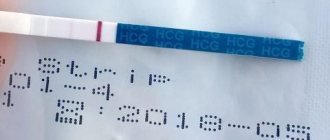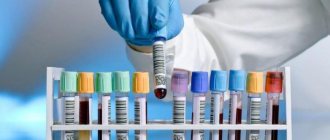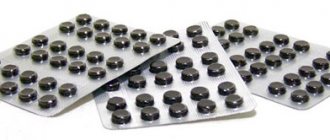Iron deficiency
Worms
Allergy
53114 10 August
IMPORTANT!
The information in this section cannot be used for self-diagnosis and self-treatment.
In case of pain or other exacerbation of the disease, diagnostic tests should be prescribed only by the attending physician. To make a diagnosis and properly prescribe treatment, you should contact your doctor. We remind you that independent interpretation of the results is unacceptable; the information below is for reference only.
Clinical blood test: indications for use, rules for preparing for the test, interpretation of results and normal indicators.
What does this analysis show?
A general blood test is one of the simplest and most significant studies. It plays a leading role in the diagnosis of many diseases. It allows you to diagnose:
- The presence of an inflammatory process (leukocytes and ESR increase).
- Anemia (anemia). The amount of hemoglobin and red blood cells decreases.
- Suspect an allergy (eosinophils are growing).
- Problems with blood clotting (decreased platelets)
- Development of infectious mononucleosis (monocytes increase and atypical mononuclear cells appear).
- Much more.
Changes in blood tests rarely indicate a specific disease. They simply confirm that not everything is in order in the body, which, in addition to existing complaints and the results of other studies, allows the patient to be diagnosed and choose treatment.
Cholesterol. Low density lipoproteins
There are two types of cholesterol:
- low density (often called “bad”). Responsible for the transport of cholesterol from the liver to tissues.
- high density (“good”) - it transports cholesterol back to the liver.
Everyone knows about the norms of total cholesterol, but today it is more important to concentrate on the levels of “bad” cholesterol (LDL). It is directly related to the condition of our blood vessels, namely the deposition of atherosclerotic plaques in them. Of course, almost all of us will have atherosclerosis to one degree or another. But with an increased LDL level, the disease develops actively and takes on more severe forms.
The normal level of LDL cholesterol is up to 2.6 mmol/l.
How do you prepare for the analysis?
In order for the data obtained to be reliable, certain requirements must be observed before submitting the analysis, which may affect the result. Blood is taken for analysis in the morning on an empty stomach. This means that the last meal should be the night before, 10 - 12 hours before the test. In some sources you can find data that at least 1 - 2 hours should pass before the material is collected. This is incorrect and may skew the results.
Important! In emergency situations, this study is done regardless of whether the patient has eaten or not, but in such cases, the expected changes in the analysis are so obvious that food intake has little effect on them.
What else you need to know about preparing for the study:
- It is not advisable to drink alcohol two days before the test.
- For 1 – 2 days you should give up fried, spicy and spicy foods.
- If possible, you should stop taking medications for a week or warn a specialist about their use.
- The day before the test, you need to avoid serious physical and mental stress.
Failure to comply with the rules and training requirements may result in distorted results. Thus, food eaten several hours before the test or alcohol taken the day before can cause an increase in the level of leukocytes in the blood. And taking certain medications completely changes the clinical picture of the blood, making you think about a non-existent pathology.
Important! All these requirements must be met if it is important for diagnosis to trace minimal changes in the blood over time. Then, to standardize the results, it is necessary that all tests take place under the same conditions. If this is not important for the doctor and the patient, then you can eat 4 to 5 hours before the test.
Indicators: norms and deviations
Most laboratories that test blood for a fee indicate reference values in the results - the “plug” of the norm. These are the ones you should focus on first.
All information presented below is taken from open sources and is primarily for informational purposes only. Only a doctor can interpret test results and prescribe medications for treatment.
C-reactive protein
C-reactive protein (CRP) is an acute phase protein of inflammation. It increases within 6 hours after the onset of the disease and increases 10-100 times within 24-48 hours.
May 28, 8:00
Is it worth testing for antibodies to coronavirus and where to do it in Barnaul?
Test for immunity to coronavirus: why is it needed, how much does it cost, how is it carried out and the dangers of asymptomatic disease
This indicator is the main laboratory marker of the activity of the process in the lungs. Its increase is directly dependent on the extent of damage to the lung tissue and is the basis for starting anti-inflammatory therapy, according to the Russian Ministry of Health.
Normally, the C-reactive protein (CRP) level should not exceed 1 mg/l. If the level of CRP exceeds 10 mg/l, this may be evidence of an ongoing infectious inflammatory disease, according to specialists from the Helix laboratory.
High levels of CRP (more than 100 mg/l) are observed with bacterial infection. With a mild viral infection, the level of CRP, as a rule, does not exceed 20 mg/l.
The clinical recommendations of the Ministry of Health for the treatment of COVID-19 indicate that exceeding 30 mg/l indicates a moderate to severe course of the viral infection. When CRP is above 60 mg/L, patients in hospitals are prescribed immunosuppressants to combat cytokine storm (excessive inflammatory response of the immune system).
CRP levels may also increase due to pregnancy, intense physical activity, oral contraceptives, and hormone replacement therapy. CRP may decrease due to the use of nonsteroidal anti-inflammatory drugs (NSAIDs), corticosteroids, statins, and beta blockers.
Leukocytes, neutrophils and ESR
Most patients with COVID-19, according to the Russian Ministry of Health, have a normal number of leukocytes. A third have leukopenia – a decrease in white blood cells (below 4*10 to the 9th degree/l). Severe leukopenia (below 1*10 in the 9th degree/l) is characteristic of a cytokine storm and requires hospitalization.
October 22, 6:04
To the pharmacy 250 km away. How Barnaul residents bought up vital medicines
Patients with chronic diseases, bacterial infections and pregnant women are forced to reserve emerging drugs
Leukocytosis (increased white blood cells) is characteristic of a bacterial infection, not a viral one. The Ministry of Health of the Russian Federation considers an indicator above 10 * 10 to the 9th power / l in combination with other signs in adults to be a basis for considering the issue of taking antibiotics. At the same time, in clinical recommendations for the treatment of acute respiratory infections in children edited by Baranov, leukocytosis is called an indicator of over 15 * 10 to the 9th degree / l.
According to the Invitro laboratory, in adults, neutrophilia (a significant increase characteristic of a bacterial infection) is considered to be more than 7.5 * 10 to the 9th power / l. Neutropenia (significant decrease) is considered to be a decrease in the absolute amount below 1.8 thousand per microliter. In recommendations for the treatment of acute respiratory infections in children, an increase in neutrophils is considered to be over 10 thousand per microliter.
The Ministry of Health of the Russian Federation does not provide exact data on the level of ESR, so it should be assessed based on laboratory reference values.
Procalcitonin
Autoimmune diseases, chronic inflammatory processes, viral infections and mild local bacterial infections rarely lead to an increase in procalcitonin of more than 0.5 ng/ml.
November 03, 6:04
Encephalitis and the tongue is larger than the mouth: how Altai children cope with Covid
In the Altai Territory, approximately 1% of children suffer from coronavirus severely, the rest are mildly ill or generally asymptomatic
Unlike other tests, the assessment of this indicator is quite expensive, so it is rarely taken during outpatient treatment. The Ministry of Health of the Russian Federation recommends taking blood for procalcitonin when patients with COVID-19 are admitted to hospital for early assessment of the risk of death and to exclude a bacterial infection.
According to the Invitro laboratory, procalcitonin levels below 0.25 ng/ml may be a reason to refrain from using antibiotics or stop taking them.
How to get tested?
The patient comes to the laboratory in the morning on an empty stomach. Blood is collected using a disposable sterile scarifier, which is disposed of in a special place after use. The instrument is opened and the finger is punctured in front of the patient. In paid institutions, children and adults can have their fingers pricked with a special lancet. This is a small needle in a plastic casing that quickly pierces the skin. With this procedure there is virtually no pain.
The puncture site is disinfected with an antiseptic solution and the first drops of blood are removed with cotton wool. Then, using an adapter, fill the tube with blood and apply it to a glass slide. The test tube is signed, and the puncture site is pressed with cotton wool treated with an antiseptic until the bleeding stops.
Glomerular filtration rate
Unfortunately, such an analysis is not usually prescribed in clinics. Although it is he who gives the most complete picture of the health of the kidneys and their performance. Reduced levels may indicate chronic kidney disease and other pathologies.
The norm is from 90 ml/min.
Viral killers. What types of hepatitis are there and how can you get infected with them? More details
Where is blood taken for analysis?
Blood is taken from the ring finger of the left hand, less often from the middle or index finger. This choice is due to the peculiarities of the anatomical structure. The little finger and thumb are connected by a common membrane to the hand, so when infected, microbes will immediately penetrate the area of the hand. Other fingers have an isolated synovial membrane, and if infection enters, it will prevent the infectious process from immediately spreading to the hand. For the puncture, choose the left (or non-working) hand and ring finger, which bears the minimum workload.
High heels
Anatomically, heels are safe for the spine - many manufacturers of women's shoes capitalize on this fact. But we are only talking about heels no more than 5 cm high. The higher the heel, the more the load on the back increases.
When you walk in heels, your feet get tired quickly
Tension and load on the spinal discs increase. These shoes have no shock absorption - the spine and legs take the entire impact. The hip joints, knees and lumbar intervertebral discs are affected.
Body tilt changes
High-heeled shoes visually lengthen your legs and make your buttocks more pronounced. This leads to uneven distribution of weight across the spine. You will be forced to “hold” your head and shoulders - and this increases the load on the lower back.
The load on the lower back increases significantly
Especially when you're bending over in high heels. The load is equal to your weight multiplied by three. So, a girl weighing 50 kg takes a load on her lower back of 150 kg.
What will the analysis show?
A standard blood test makes it possible to evaluate:
- hemoglobin level and red blood cell count;
- number of leukocytes and their formula (percentage);
- platelet level;
- ESR.
The results of the study are recorded on a special form, where the reference values of the norm for each indicator are written on a separate line. A clinical blood test is a simple and reliable method for diagnosing changes in the general condition of the body. In order for the results obtained to correspond to reality and to be able to compare them over time, the patient must comply with the requirements for preparing the analysis.
Glycated hemoglobin
If you already have diabetes, then you need to test glycated hemoglobin (HBA1C). It allows you to assess how well you compensate for carbohydrate metabolism and determine your risk of complications. It’s a sad fact, but insidious diabetes mellitus entails many consequences. According to statistics, every 6 seconds one person dies from complications of diabetes.
Glycated hemoglobin values:
Up to 6.2% - no diabetes;
5.7-6.4% - impaired glucose tolerance, high risk of developing diabetes;
6.5% and more have diabetes.
Some important points
There are certain norms for the level of the above cells in the blood. They are usually indicated on the test result form. Therefore, the patient himself can determine whether the content of certain cells is normal. But only a doctor can give an accurate interpretation of the analysis.
Patients who are afraid to donate material from a finger prick for some reason may ask their doctor whether it is possible to take a general blood test from a vein.
Platelets
The norm is 150-400 *10^9/l.
These 10 blood indicators will tell you everything about your health. Plus take a general urine test every year. Many serious diseases arise quietly and asymptomatically, but when manifestations begin, this means that the disease is already “in its prime.” Check your health once a year, and then you won’t be able to wait for advanced diseases.
If small deviations from the norm are suddenly noted, there is no need to panic. Here it is better to consult a doctor who can correctly identify the problem or understand whether the situation is critical in principle.











